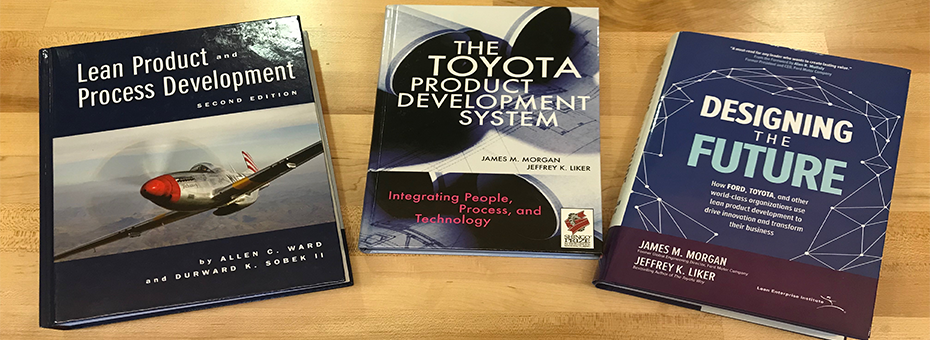“I have heard great things about LPPD. I want to learn about it, where should I start?”. This is one of the most frequent questions I get from people in my company. People have heard success stories from teams using LPPD methods, and want to improve their part of the company, from engineering and product design, to HR and IT. It often starts when process owners inside the company begin “pulling” for information on LPPD. In my company the demand for these great tools and behaviors was encouraging, but we are just starting out, and our lack of internal teaching resources has caused a problem. As a stopgap, I wrote the following advice to my coworkers, and now the lean community, just starting out with LPPD.
Learning and applying the concepts of LPPD is no different than learning any other new skill in life. For this article, my extremely oversimplified learning cycle is three steps (repeated many times, over many years); self-study, getting a coach, and practicing. Let’s get started.
Self Study
The first step is to start consuming information through reading and some simple videos. This is the equivalent of a fast and cheap experiment. You can get a good idea of the potential benefit, and time investment required for success. I suggest starting small and working your way up. I recommend that you read through Jim Morgan’s LPPD e-letters. Start back in 2013 and work your way up. Each article is about a 10 minute read.
After that I would recommend this great video introducing LPPD:
Once you have a taste of what this is about and you want to invest more time, the next step is to get some books and dive in deeper. Set some time aside for one of these:
- Lean Product and Process Development by Allen Ward and Durward Sobek.
- Designing the Future by Jim Morgan and Jeffrey Liker.
- The Principles of Product Development Flow by Donald G Reinertsen.
- The Toyota Product Development System by Jim Morgan and Jeff Liker.
Keep in mind this list is not exhaustive, it is just a starter. The LEI website has many great LPPD resources.
Learning is about adding layers of knowledge, and lessons, EVERY DAY to become proficient. Pick a book, read it, and move to the next step. If you are serious about this, you will cycle back to “self study” later to read the others, and more, in the future.
Get a Coach
Your second step is to get a coach. A coach will multiply your learning rate by a factor of between 10 and 100. If you are serious about applying lean to your work over the long term, this isn’t optional.
Companies like Toyota have been doing this for so long, they have built an internal coaching and learning ecosystem. If you are reading this, then it is likely your company is at the beginning of its journey, and your internal coaching capability is likely small to nonexistent. Not to worry though: coaching power grows exponentially over time, so you just have to hack the system for a while. Two solutions I suggest are to; hire a coach from outside, or form an LLPD learning group inside your company. The LPPD learning group is a team of people you gather together regularly to talk about what each of you are learning (step one) and practicing (step three). Though not as effective as a coach, the energy and peer pressure of the team will compress the learning cycles faster than an individual can. At some point, the team will need to call in some outside help. This can be the direct hire of a coach, or sending the team to interact with others at the LPPD conference. In addition, finding a local company on their LPPD journey and forming a learning partnership with them can accelerate learning.
Practice
Step three is to practice. To become great at any skill, you cannot just read and talk about it. You must put the concepts into practice. Your coach, or support team, will help you do this. To start practicing, first focus on a single problem with the following characteristics:
- A manageable scope. Something that can be experimented with by few people in a few weeks. Mastering a skill is about many layers of knowledge. The faster you can cycle and layer knowledge, the steeper your learning trajectory. So, pick short and manageable problems first.
- Be impactful. It will be tempting to make improvements to some offline or low use process for a quick win. Resist the temptation. Push hard to solve a problem that is clearly wasting the time of employees in your company. When people see the results that matter to them, they will be more likely to support the changes, and get involved in the next improvement attempt.
- Be low friction. Sometimes you may think you picked something with a manageable scope, only to find out there are so many stakeholders that it takes you weeks or months to do what should be a day of work. Chose something you and your team can affect.
It may sound difficult to find such a problem. But, I guarantee they are all around you. Just “go and see” the people doing the work. They know exactly what is wasting their time.
Bringing it Home
The self-study material is all out there for easy consumption. But mastering a skill happens just like it always has, through hard work and practice. Regular improvements add up to big changes over time. If you aren’t making daily or weekly progress, you are moving too slow. You have improvements to make, and a coaching community to build so, don’t wait another day, get started now.
Designing the Future
An Introduction to Lean Product and Process Development.





